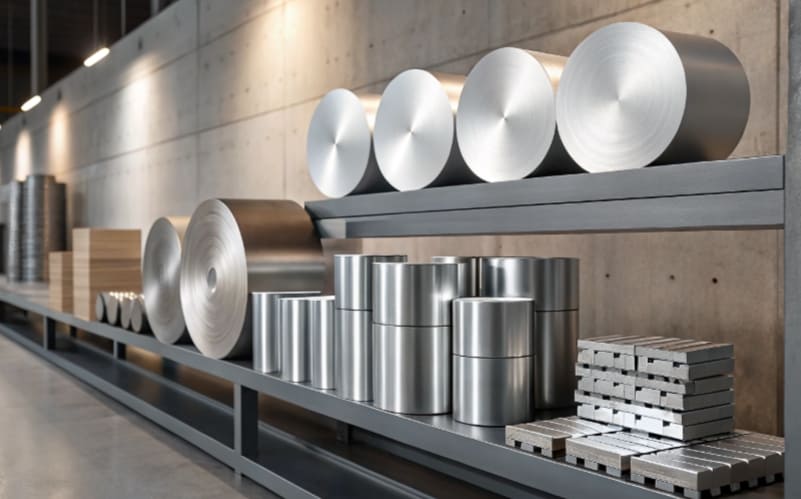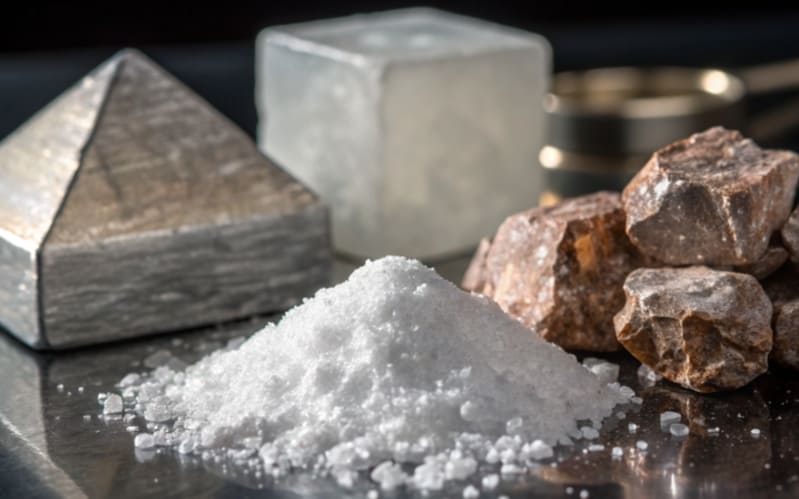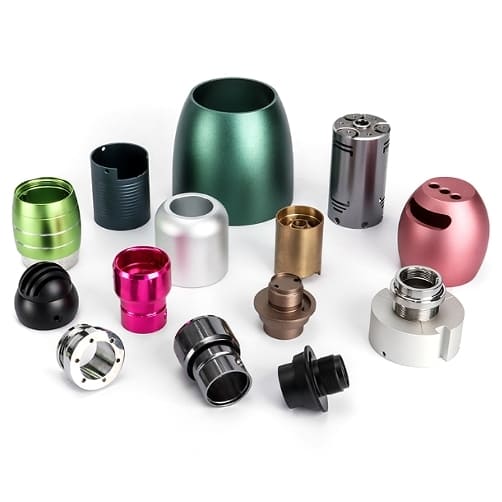Lightweight metals play a pivotal role in industries like aerospace, automotive, and consumer electronics. As technology advances, these metals are increasingly sought after for their high Strength-to-weight ratio1. But what exactly are they, and why are they so valuable? Let’s dive into it.
Lightweight metals are materials with low density, offering both strength and flexibility, making them ideal for various industrial applications.
With this basic understanding, let’s explore the different types of lightweight metals and their unique properties.
What are the Types of Lightweight Metals?
Lightweight metals come in several varieties, each with its unique characteristics. From aluminum to titanium, these materials are designed for different purposes.
The most common lightweight metals are aluminum, titanium, magnesium, and beryllium. They are favored for their ability to be strong yet light in weight.

When choosing a lightweight metal, it’s essential to consider factors like strength, corrosion resistance, and cost. For example, aluminum is highly corrosion-resistant, while titanium offers exceptional strength at lower weights. Magnesium, though lighter, is typically used in specific applications where weight is a critical factor. Beryllium, on the other hand, is used in specialized applications due to its unique combination of lightweight properties and high stiffness.
Aluminum
Aluminum is known for its excellent corrosion resistance and high strength-to-weight ratio. It is easily machinable and often used in applications where low weight and durability are critical.
Properties:
High electrical conductivity
Excellent corrosion resistance
Lightweight and malleable
Common Uses:
Aerospace, automotive, and consumer electronics.
Titanium
Titanium is one of the strongest lightweight metals, offering both strength and corrosion resistance. Although more expensive than aluminum, its high strength-to-weight ratio makes it ideal for high-performance applications.
Properties:
Extremely strong and lightweight
High resistance to corrosion, even in extreme environments
Biocompatible2 (ideal for medical implants)
Common Uses:
Aerospace, medical implants, marine applications.
Magnesium
Magnesium is the lightest of the commonly used structural metals. While it is less strong than aluminum and titanium, it offers excellent weight-saving properties.
Properties:
Extremely low density
Good vibration damping characteristics
Prone to corrosion, especially in harsh environments
Common Uses:
Automotive (e.g., engine blocks, wheels)
Aerospace
Electronics
Beryllium
Beryllium is known for its exceptional strength and stiffness-to-weight ratio. Although it is toxic in its dust and vapor forms, it is used in a variety of high-performance industries, including aerospace and electronics.
Properties:
High stiffness and strength
Low density
High thermal conductivity3
Common Uses:
Aerospace components
Precision instruments
X-ray equipment
What is the Difference Between Light and Heavy Metals?
Understanding the difference between light and heavy metals is key to choosing the right material for your needs. While the distinction might seem simple, it has broad implications in material science.
Light metals have a lower density than heavy metals, which makes them suitable for applications that require less weight, like aerospace and automotive industries.
Heavy metals, on the other hand, have higher densities and offer more durability and strength under high-stress conditions. But, they can be cumbersome, expensive, and challenging to work with, making them less suited for weight-sensitive applications.
Key Differences:
- Density: Light metals (e.g., aluminum, magnesium) typically have densities under 5 g/cm³, whereas heavy metals (e.g., lead, gold) have densities greater than 7 g/cm³.
- Strength-to-Weight Ratio: Light metals excel in this category, offering a good balance between strength and weight.
- Cost: Light metals are generally more cost-effective, while heavy metals tend to be more expensive and harder to process.
What Are the Three Lightest Metals?
Curious about the lightest metals available? Here’s a breakdown of the top contenders.
The three lightest metals are lithium, sodium, and potassium.

Lithium, in particular, is widely used in batteries due to its low weight and high energy density.
These metals are not typically used in structural applications due to their softness and reactivity. However, their low density makes them useful in very specific contexts like lightweight battery technology.
Lithium
Lithium is the lightest solid element and is crucial in energy storage systems, such as rechargeable batteries for electric vehicles and mobile devices.
Properties:
Extremely low density
High Electrochemical potential4
Reacts with water and air
Common Uses:
Rechargeable batteries (e.g., Li-ion)
Heat-resistant glass
Sodium & Potassium
Sodium and potassium are also highly reactive metals that are lighter than other structural metals. They are rarely used in pure form but find applications in chemical reactions and as heat storage materials.
Properties:
Highly reactive, especially with water
Used in chemical manufacturing
Conductive in molten form
What is a Lightweight Metal That is Strong?
Some lightweight metals are designed to be exceptionally strong, allowing them to withstand high pressure and heavy loads while maintaining low weight.
Titanium is one of the strongest lightweight metals, combining strength with relatively low weight and excellent corrosion resistance.
Titanium alloys are commonly used in industries like aerospace and medical implants, where strength and lightweight characteristics are crucial. However, it can be more expensive compared to other metals like aluminum.
Other Notable Strong Lightweight Metals:
- Aluminum alloys: High strength-to-weight ratio when alloyed with materials like copper, manganese, and silicon.
- Magnesium alloys: Stronger than pure magnesium, used in automotive and aerospace industries.
What is the Cheapest Lightweight Metal?
When considering the cost of lightweight metals, price can often be a determining factor in industrial applications.
Aluminum is the cheapest lightweight metal, making it a popular choice for industries requiring large quantities of material at a low cost.
Though less strong than materials like titanium or steel, aluminum is widely available, easy to work with, and incredibly versatile. It’s commonly found in everything from beverage cans to car parts.
Aluminum Cost Factors:
- High availability makes it less expensive.
- Recycling aluminum reduces cost and energy use significantly.
- Aluminum’s versatility in manufacturing and shaping keeps labor costs low.
What Are the Useful Lightweight Metals?
There are several lightweight metals that offer both functionality and versatility. Let’s take a look at some of the most useful ones across various industries.
Aluminum, magnesium, and titanium are among the most useful lightweight metals due to their balance of strength, weight, and corrosion resistance.

While each of these metals has specific strengths and weaknesses, they all offer a combination of lightweight properties and strength that make them invaluable in industries that require high performance and efficiency. Whether you are designing an aircraft, a car, or an electronic device, these metals help achieve optimal results while minimizing weight and maximizing durability.
What Lightweight Metal Does Not Rust?
Rusting is a major concern when it comes to materials used in outdoor or high-moisture environments. So, which lightweight metals stand up best to corrosion?
Titanium is a prime example of a lightweight metal that does not rust, making it ideal for marine applications and other environments with high humidity.
Aluminum is another metal with strong corrosion resistance, though it can oxidize over time. However, unlike rust, the Oxidation5 forms a protective layer that prevents further damage.
Other Corrosion-Resistant Metals:
- Magnesium: Prone to corrosion, but surface treatments can improve resistance.
- Beryllium: Very corrosion-resistant in its alloys, especially when exposed to heat or moisture.
What is the Strongest Lightweight Metal?
When you need both low weight and high strength, it’s important to know which lightweight metals can handle the job.
Titanium is the strongest lightweight metal, offering superior strength-to-weight ratios compared to other metals.
This makes titanium the go-to choice for high-performance applications like jet engines, surgical implants, and even spacecraft construction. However, its high cost limits its widespread use.
Is Titanium Stronger Than Steel?
Many people wonder how titanium stacks up against steel in terms of strength. While steel is known for its toughness, how does titanium compare?
Titanium is generally as strong as steel but weighs much less. However, steel has superior tensile strength6 and is more durable in certain conditions.
In applications where weight is a critical factor, such as aerospace, titanium often outperforms steel. But for applications requiring high impact resistance7, steel still has the edge.
What’s Lighter, Aluminum or Titanium or Magnesium?
Each of these metals has its advantages when it comes to weight, but which is the lightest?
Magnesium is the lightest of these three metals, followed closely by aluminum, while titanium is the heaviest.
Magnesium’s low weight makes it ideal for aerospace and automotive applications, although it’s more prone to corrosion than aluminum and titanium.
What is Stronger, Aluminum or Magnesium or Titanium?
Now that we know about their weights, let’s compare their strength. Which metal holds up best under stress?
Titanium is the strongest, followed by aluminum and magnesium.
Titanium’s superior strength allows it to perform in high-stress environments, while aluminum and magnesium offer sufficient strength for less demanding applications.
Conclusion
Lightweight metals are essential in industries where strength and low weight are crucial. By understanding their properties, you can choose the right material for your needs, whether you’re designing an aircraft, a car, or a simple everyday product.
-
Understanding the strength-to-weight ratio of metals is critical when designing products that need to be both lightweight and durable. ↩
-
Understanding biocompatibility is crucial for ensuring medical devices are safe and effective for human use, impacting patient health and device performance. ↩
-
Understanding thermal conductivity is crucial for materials science and engineering applications, offering insights into heat transfer efficiency. ↩
-
Understanding electrochemical potential is essential for predicting chemical reactions, energy storage, corrosion behavior, and designing efficient batteries, fuel cells, and other electrochemical systems. ↩
-
The oxidation process of aluminum doesn’t harm its functionality. It creates a protective barrier that can enhance the material’s durability, especially in outdoor or moist environments. ↩
-
Tensile strength is a critical property for metals used in structural applications, especially in extreme conditions. ↩
-
Impact resistance is a key factor for materials used in high-risk environments, such as automotive or aerospace industries. Understanding these properties helps you choose the right material based on both strength and durability. ↩
